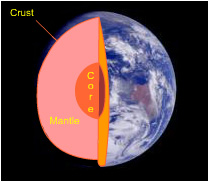Sodium Through Argon
|
Our planet is a three-layered ball of silicates. It passed through a stage with a molten interior soon after its formation, and the heaviest materials sank to the center to build an iron-nickel core 3500 kilometers (km) in radius. Around this core, various metal silicates stratified according to density. The mantle, nearly 3000 km thick, consists mainly of a dense crystalline aggregate of olivine, an iron-magnesium silicate. Olivine has the formula X2SiO4, in which X can be Mg2+ or Fe2+ in any proportions. SiO44- silicate tetrahedra are packed together in the tightest possible way in olivine; thus the mineral is very dense. |
A combination of high pressure and high temperature makes the material of the mantle semifluid even today, and convection currents in the mantle are the principal forces in continent-building. Less dense silicate minerals are produced if the SiO44- tetrahedra are linked into long chains. Each Si then shares two of its O atoms with two other Si atoms, leaving it with a net of 3 oxygens (1+1+1/2+1/2), and two negative charges on its two wholly owned oxygen atoms. The overall composition of these chain silicates is SiO32-. These chains have only half the negative charge per Si atom that olivine has, and hence need fewer metal ions to counterbalance the charge. Because of this, and also because of the open way in which the chains are packed in the mineral, chain silicates are less dense than olivine. Many of them floated to the top of the mantle and helped build the crust, the outer layer of the planet, which is about 33 km thick under the continents but only 5 km thick beneath the ocean basins. Pyroxenes are single-chain silicates, with the chains held together by positive ions. Amphiboles are double-chain, or ladder, structures. |
